Table of Contents
About Lilies
Lilies are flowers with large and showy petals which bloom from summer to fall, adding extra elegance to the garden.
Blooms come in beautiful colors including pink, red, gold, white, and orange. The flowers have six strikingly marked or plain petals, often sitting on long, narrow stems with lance-shaped leaves.
The petals are mostly trumpet-shaped. Lilies are perennial flowers that need minimal care, as long as they are planted in the right places.
Naturally, lilies grow in the wild across North America, Asia, and Europe and as the civilizations grew, they started noticing and adopted this beautiful flower.
Over time, when the Europeans started exploring other continents, exotic breeds of lilies were discovered and adopted from the Americas, Africa, Asia, and Australia.
In the early 1920s, Jan De Graff, a lily enthusiast, developed an immaculate breeding program. His efforts brought about new hybrids which were ideal for cut flowers, containers, and gardens and the lilies’ popularity has grown ever since.
There are several clusters of lilies, and just like all the other lilies, pink lilies are part of the many clusters of lilies. Before getting into details about pink lilies, it is good for you to know about these clusters first.
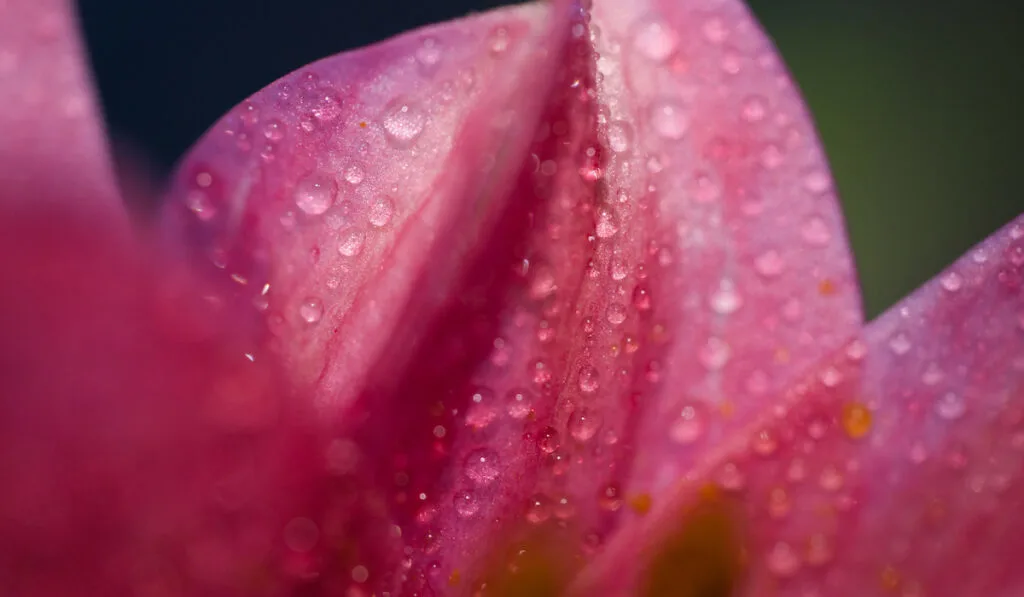
Clusters of Lilies
Different lilies have different and unique traits specific for their kinds, such as tolerating partial shade and early flowering, while others could be best cut for bouquets or grown in containers.
Through these shared traits, lilies are put in clusters called divisions. Let’s take a look.
- Asiatic hybrids (Division 1) – Though most may be dwarf, Asiatic lilies are just as beautiful as other lilies. Normal Asiatic lilies could bloom from early to mid-summer at a maximum of 30 inches tall in the first year and maybe less in the following years. Dwarf cultivars could reach about 16 inches. The dwarf types are suited for a small garden.
They result from crossing Asian species like the Tiger-lily with native European hybrids. To grow them successfully, you have to ensure there is enough organic matter and lime in the soil, as well as a good drainage system.
- Martagon-type Hybrids (Division 2) – These lilies are famous for their bright, showy petals that curve back towards the stalk. This type is not hard to plant and maintain, because it is not picky about soil, provided there is sufficient drainage.
- Candidum Hybrids (Division 3) – This hybrid is also known as the Madonna lily.
- American Species Hybrids (Division 4) – They usually have pendant blooms with whorled foliage that spreads outwards with time. The leopard lily (L. pardalinum) is the backbone lily for this hybrid.
The most ideal environment for this hybrid is around shrubs or little woodlands. They should be handled with care because they are delicate.
- Longiflorum hybrids (Division 5) – The Easter lily is the most well-known of this hybrid type. They are not likely to survive harsh conditions, compared to its subsequent hybrids, who are more resilient.
- Trumpet Hybrids (Division 6) – These are the classic funnel-shaped that people imagine whenever they think of lilies. They are often large and stand out among other plants, making a bold statement with colorful petals and an elegant lily fragrance.
They are good for both flower beds and containers, provided there is enough organic matter in the soil.
- Oriental hybrids (Division 7) – The Oriental hybrids have large petals that are slightly recurved. They turned out to be more robust than the original hybrid parents, the L. aurutum and L. speciosum in both beauty and fragrance. They do best in pots and containers with ericaceous compost.
- Inter-Divisional Hybrids (Division 8) – They are mainly lilies that have recently been crossed by scientists for more resilience and elegance.
- Wild lilies (Division 9) – They are the original lilies that make up the baseline for the breeding of more exotic lilies. They are just as lovely and even more characterful.
This article however is about pink lilies. Now that we have an idea about the general divisions of lilies, let’s take a look at pink lilies, randomly chosen from the clusters.
1. Lilium speciosum (Oriental Lily)

This species is originally from Japan and is the classic late bloomer, flowering in early autumn.
The blooms are always pink but can at times be white with darker pink spots, and are well spaced on the narrow stems. They also have an elegant fragrance. Given the right conditions, Oriental lilies can grow to heights of 4 – 5 feet.
Growing Oriental lilies is quite easy, provided there is favorable and lime-free ground for the bulbs, with plenty of sunshine and good drainage, since they cannot grow on boggy soil.
You could consider growing them in containers with ericaceous compost in case that you have alkaline soils. Their soil should also have organic matter for more nutrients and increased drainage.
Their blooms can at times be excessively large and can flop over, threatening the stem. It is recommended to stake them until the flowers wither. The annual addition of slow-release fertilizer is also good for your bulbs.
2. Lilium martagon (Martagon Lily)
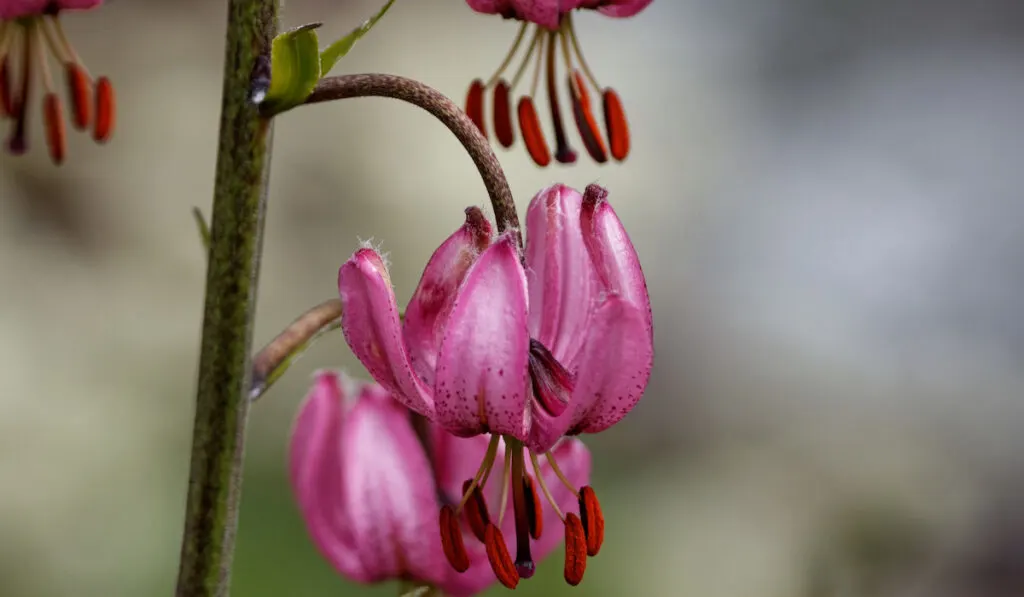
The Martagon lily is extremely adaptable and can go wild expanding its reach for many years. It is pink to soft purple in color, but can at times be albino white.
The Turks cap-shaped blooms curve right back to touch the flower’s base, with the stalk growing to 4- 5 feet under optimal conditions.
This species has both male and female gametes and is also self-fertile. It is mainly pollinated by moths and butterflies.
The bulbs could be planted in light shade or in plenty of sunshine, in moister soil. This breed is not fussy about soil and can grow and do well on almost any soil, with no specific pH value.
Just like other lilies, their soil should have sufficient drainage. They are most suitable for natural planting schemes, as they blend well with other flowers in the garden.
3. Lilium ‘Roma’
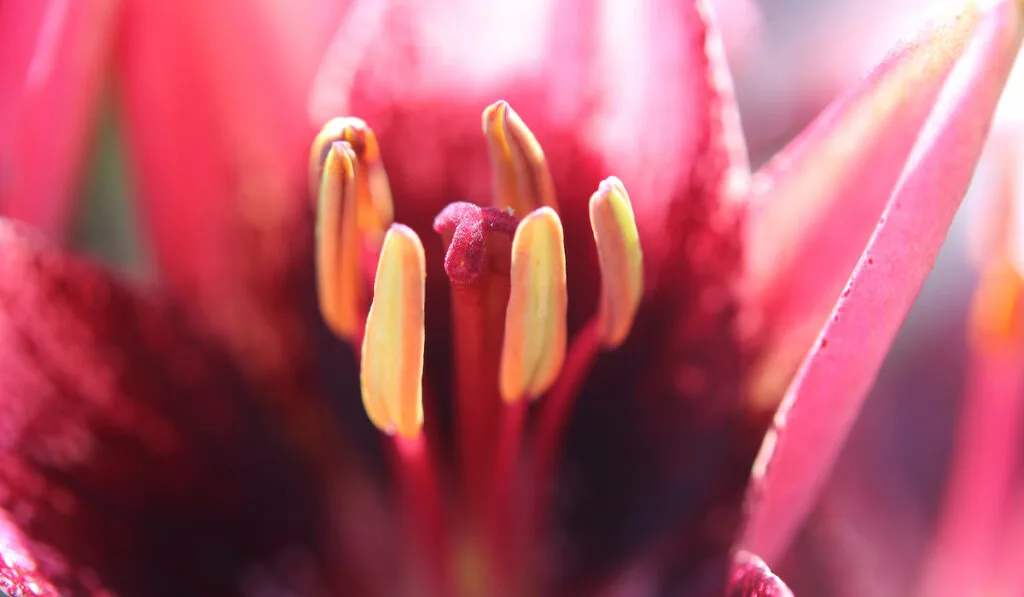
This lily hybrid is stately and elegant but blooms later than other Asiatics. They have pink buds that open into bold, creamy blossoms with a delicate arrangement of spots near the center. They bloom in early summer and enjoy partial shade to full sunlight.
Under optimal conditions, the stem grows to a height of 4 feet at maturity, with a spread of about 18 inches. They are a bit leggy and should therefore be well spaced when grown in masses. The stalks grow at a fast rate and may be weak, therefore needing support.
They should also be planted in extremely rich soils with proper drainage but averagely moist and do not require specific pH. They are excellent for cutting and arranging.
4. Lilium ‘Tom Pouce’

The ‘Tom Pouce’ is famous for its large, magnificent flowers which are over 8 inches wide, and bloom in mid to late summer.
The soft pink flowers have a yellow stripe at the middle that beautifully contrasts with the dark brown stamens.
With numbers of about 5 – 10 on a stalk, they stand out boldly and add fragrance to the garden. At full maturity, they could reach 2 – 3 feet tall.
The ‘Tom Pouce’ is not picky about soil and will do just fine in any, provided it has proper drainage. They are also good for containers and since they bloom in numbers, they will provide plenty of elegant flowers to cut.
5. ‘Denia Pixie’ Lily
Being one of the dwarf lilies, this cultivar was specifically meant for containers but does well in the garden as well.
They often bloom in early summer with bold pink, trumpet-shaped blooms. Their lovely pink blossoms with yellow centers and dark spots are well suited for low edgings and borders. They are also excellent for cutting.
When growing in large numbers, consider a spacing of about 8 inches. They do well in partial shade or when fully exposed to sunlight. At optimal conditions, the stems grow to over 18 inches at maturity.
For optimal growth, this breed does not tolerate stagnant water, so the drainage should be well-defined. They are not also picky or specific to a certain soil type or pH.
6. Oriental Lily ‘Acapulco’
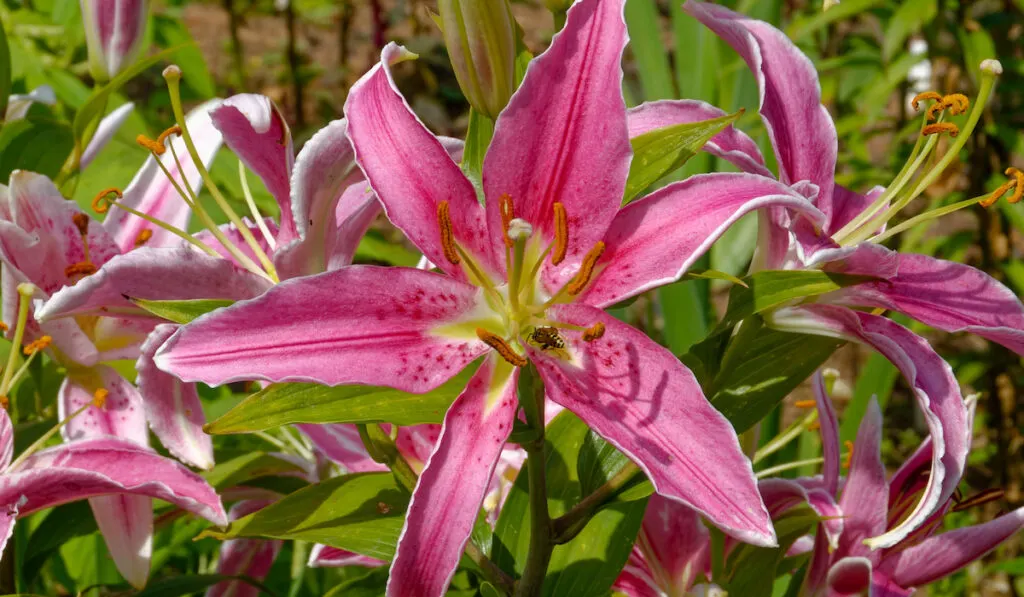
The Oriental lily ‘Acapulco’ is the ultimate lily for pink lovers. Originally, it was meant for the cut flower markets, but it does well in gardens too.
They bloom in mid to late summer and upon maturity, they can produce 3 – 5 blooms in the first year and many more in the subsequent years.
They are very fragrant, making them perfect for cut flowers and bouquets. Each flower has a center dusting of darker pink spots, and the outer petals are slightly ruffled. Upon maturity, the flower stalks can reach 4 feet tall.
Like other lilies, the ‘Acapulco’ bulbs do well in partial shade to full sun. They are not also picky on a particular soil or pH, but the soil should have enough organic manure, as well as proper drainage to avoid excessive moisture that could rot the bulb and roots.
7. Lilium ‘Heartstrings’
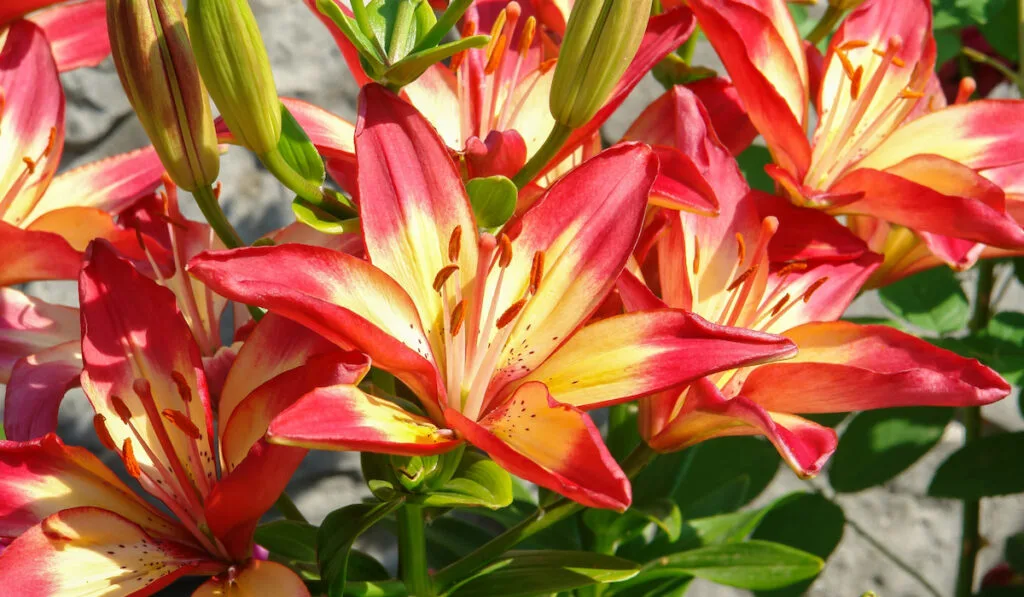
The lily ‘Heartstrings’ is a boldly beautiful flower with pale yellow centers complimenting the pink tips of the petals. They often bloom in early summer, blessing your garden with bold beauty, elegance, and fragrance.
The bulbs should be planted ideally in spring. You should however check your soil type, as this breed, in particular, is more suited for alkaline soils. When planting in the garden, ensure that you have proper drainage, and know the soil pH.
If unsure of the alkalinity, it is best to consider planting them in containers. Proper spacing of about 5-8 inches should also be given to individual bulbs and should be planted 4-6 inches deep.
‘Heartstrings’ lilies in both gardens and containers do well when exposed to full sun or partial shade.
8. ‘Elodie’ Lily
The ‘Elodie’ lily has a semi-double bloom which gives it an impression of twice as special.
Its pollen-free status makes it an ideal choice for cut flowers and bouquets. At maturity, an ‘Elodie’ lily will reach 4 feet tall with 5-6″ flowers.
They do well in both neutral and alkaline soils. If you are unsure about your soil, plant them in containers. Enough moisture in the soil, but adequate drainage is also essential for this cultivar to avoid root and bulb rot.
The soil should also be enriched with organic matter for more nutrients for the lily. Whether in a container or in a garden, they do well when exposed to full sun or in partial shade.
Conclusion
Pink lilies are known to add bold signatures of beauty, elegance, and fragrance to any space. The above list is just but a few common pink lilies. Among other pink lilies are the ‘Stargazer’ lily, ‘Lollypop’ lily, and Turk’s cap lily among others.
Caring for them, however, could be a challenge if you are not careful to check the little details pertaining to every kind of lily, from their appropriate soil to the light exposure required for their optimal growth.
You are also free to water them to keep the soil moist, as long as you avoid stagnant water, which could lead to the rotting of the bulb and roots.
Resources
- https://www.almanac.com/plant/lilies
- https://www.gardeningchores.com/types-of-lilies/
- https://www.floraqueen.com/blog/the-pink-lily
- https://www.countryliving.com/gardening/g32149452/lilies-types/
- https://www.gardeningknowhow.com/ornamental/bulbs/lily/oriental-lily-plant-care.htm
- https://pfaf.org/user/Plant.aspx?LatinName=Lilium+martagon
- https://search.shelmerdine.com/11050002/Plant/2773/Roma_Lily/
- https://www.gardenia.net/plant/lilium-tom-pouce-lily
- https://plants.alsipnursery.com/12120002/Plant/7422/Denia_Pixie_Lily/
- https://www.missouribotanicalgarden.org/PlantFinder/PlantFinderDetails.aspx?taxonid=261545&isprofile=0&
- https://www.bdlilies.com/l7390.html
- https://www.hartsnursery.co.uk/Heartstrings.html
- https://www.shootgardening.co.uk/plant/lilium-elodie
